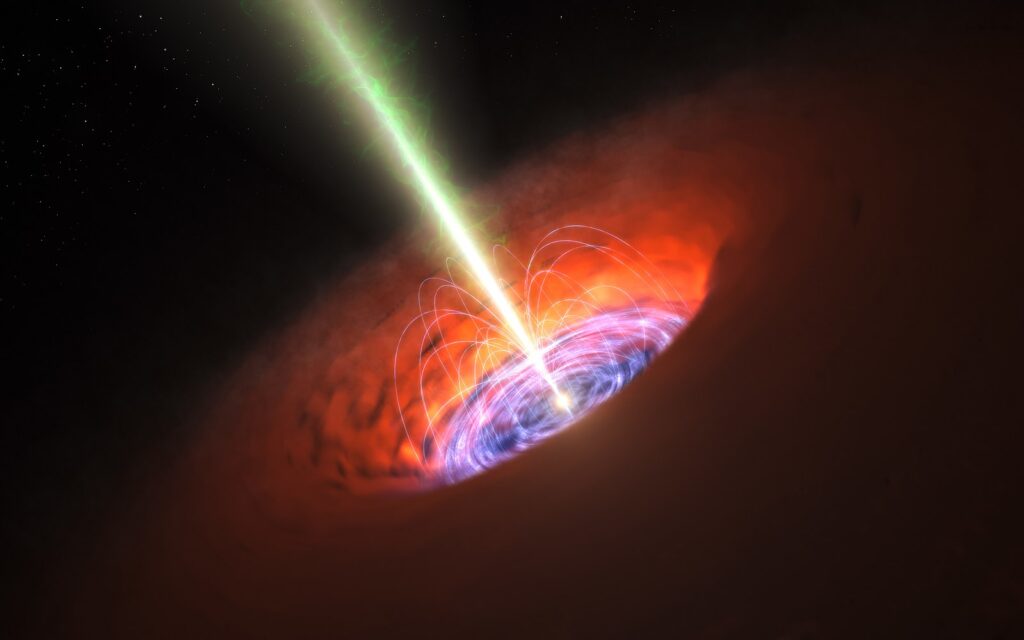
This artist’s impression shows the surroundings of a supermassive black hole, typical of that found at the heart of many galaxies. The black hole itself is surrounded by a brilliant accretion disc of very hot, infalling material and, further out, a dusty torus. There are also often high-speed jets of material ejected at the black hole’s poles that can extend huge distances into space. (Wikipedia)
Move over NASA! Israeli astronomers from Ben-Gurion University in the Negev detected an “extremely red supermassive” black hole in the early universe growing in the shadows. Supermassive black holes are the largest type of black hole, possessing masses ranging from millions to billions of times the mass of our sun.
So, this discovery could help to explain the secrets around the formation of the universe.
Analyzing images from the James Webb Space Telescope (JWST), a group of astronomers led by Dr. Lukas Furtak and Prof. Adi Zitrin from Ben-Gurion University of the Negev detected an extremely red, gravitationally lensed supermassive black-hole in the early Universe. Its colors suggest that the black hole lies behind a thick veil of dust obscuring much of its light. The team managed to measure the black hole mass and discovered that it was significantly more massive, compared to its host galaxy, than what has been seen in more local examples. The finding was published in Nature two weeks ago.
Will you offer us a hand? Every gift, regardless of size, fuels our future.
Your critical contribution enables us to maintain our independence from shareholders or wealthy owners, allowing us to keep up reporting without bias. It means we can continue to make Jewish Business News available to everyone.
You can support us for as little as $1 via PayPal at office@jewishbusinessnews.com.
Thank you.
The early universe is a fascinating and mysterious period in the history of our cosmos. Our current understanding suggests that it began with the Big Bang, a momentous event roughly 13.8 billion years ago. In the first fractions of a second, the universe was incredibly hot and dense, existing in a state known as the Planck epoch. The known laws of physics may not have even applied during this time.
Found at the center of the galaxy, Supermassive black holes are fascinating objects that hold clues to the evolution of galaxies and the universe as a whole. Understanding their formation, behavior, and interaction with their surroundings is a key area of astrophysical research.
The astronomers detected in JWST images what seemed to be a lensed, quasar-like object from the early universe. Quasars are bright active galactic nuclei: supermassive black holes in the centers of galaxies that are actively accreting material.
The accretion of material onto the black hole emits copious amounts of radiation that over shine the host galaxy, leading to a compact and bright, star-like appearance.
Since the cluster contains large amounts of mass it bends space time — or the paths of light rays traveling near it — effectively creating a gravitational lens. The gravitational lens magnifies the background galaxies behind it and allows astronomers to observe even more distant galaxies than otherwise possible.
“We were very excited when JWST started sending its first data. We were scanning the data that arrived for the UNCOVER program and three very compact yet red-blooming objects prominently stood out and caught our eyes,” says Dr. Lukas Furtak, a postdoctoral researcher at BGU and the lead author of the discovery papers. “Their “red-dot” appearance immediately led us to suspect that it was a quasar-like object”.
Furtak and the UNCOVER group started investigating the object. “We used a numerical lensing model that we had constructed for the galaxy cluster to determine that the three red dots had to be multiple images of the same background source, seen when the Universe was only some 700 million years old”, says Prof. Zitrin, an astronomer at BGU and one of the lead authors of the discovery papers.
“Analysis of the object’s colors indicated that it was not a typical star-forming galaxy. This further supported the supermassive blackhole hypothesis”, says Prof. Rachel Bezanson, from University of Pittsburgh and co-lead of the UNCOVER program. “Together with its compact size, it became evident this was likely a supermassive black hole, although it was still different from other quasars found at those early times”, Prof. Bezanson added. The discovery of the uniquely red and compact object was published last year in the Astrophysical Journal. But that was just the beginning of the story.
The scientists also discovered that the black-hole’s mass seems to be excessively high compared to the host galaxy’s mass. They explained that all the light of that galaxy must fit within a tiny region the size of a present-day star-cluster. The gravitational lensing magnification of the source gave “exquisite limits” on the size. Even packing all the possible stars into such a small region, the black hole ends up being at least 1% of the total mass of the system,.
Astronomers do not know if such supermassive black-holes grow, for example, from stellar remnants, or perhaps from material that directly collapsed into black holes in the early Universe.
“In a way, it’s the astrophysical equivalent of the chicken and egg problem”, says Prof. Zitrin. “We do not currently know which came first – the galaxy or black hole, how massive the first black holes were, and how they grew.”



